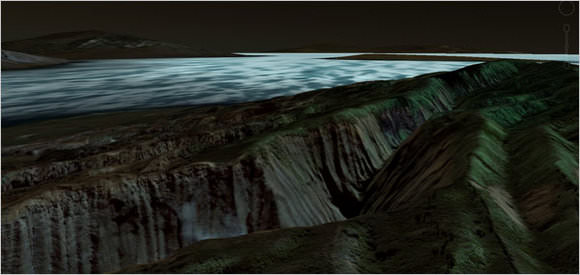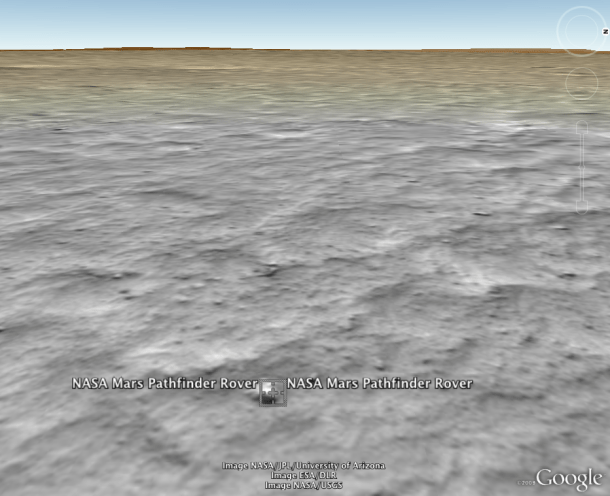[/caption]
Google Earth now allows you to probe the depths of Earth’s oceans as well as fly through the giant canyons or volcanoes on Mars. Google Earth 5.0 was unveiled today, with substantial upgrades for both the Earth and the Red Planet. Google worked in conjunction with NOAA and NASA to incorporate data from our undersea explorations and the spacecraft orbiting Mars. For the first time, you’ll be able to look at the two-thirds of our planet covered by the oceans, take a tour below sea level, and even look at historical imagery to see things like coastal erosion. On Mars there’s a rich conglomeration of images, including the most recent from the Mars Reconnaissance Orbiter to provide an immersive 3D view of Mars. Marine scientists say the electronic images will boost awareness and increase public support for marine conservation, while NASA says the new features in Google Mars will aid public understanding of Mars science, while also providing researchers a platform for sharing data similar to what Google Earth provides for Earth scientists.
In Google Oceans, you can click a function called Touring and you can create narrated, illustrated tours, on land or above and below the sea surface, describing and showing things like a hike or scuba excursion, or even a research cruise on a deep-diving submarine.

By choosing among 20 buttons holding archives of information, called “layers” by Google, a visitor can read logs of oceanographic expeditions, see old film clips from the heyday of Jacques-Yves Cousteau and check daily Navy maps of sea temperatures.
While only 5% of the ocean floor is mapped in detail, the replicated seas have detailed topography reflecting what is known about the abyss and continental shelves with rougher areas where little is known.
On Mars, you can enjoy a high-resolution, three-dimensional view of the Red Planet.
There is a mode that enables users to fly virtually through enormous canyons and scale huge mountains on Mars that are much larger than any found on Earth. Users also can explore the Red Planet through the eyes of the Mars rovers and other Mars missions, providing a unique perspective of the entire planet.
Clickable links allow you to learn about new discoveries and explore indexes of available Mars imagery. If you’re into working with the raw images from the Mars rovers or orbiting spacecraft, the new Mars mode also allows users to add their own 3D content to the Mars map to share with the world.
Since 2005, Google Earth has been downloaded on half a billion computers, and visitors spend one million hours a day perusing Google Earth and the related Google Maps.
Guess what I’ll be doing the next few hours!
Sources: NASA, New York Times


I’ve been trying to download it for 2 hrs now – the updater just won’t suck it down. I’m guessing their getting slammed.
I’ll keep trying…..
I won’t even try. I’ll wait for the enthusiasm of the speedsters to subside, and then I’ll download my update with all comfort… 😉
Of course, if many of you do as I do, I may give it a shot later tonight… 😉
it doesn’t let me install it 🙁
It’s like WallE goes exploring….yipeee
I have been waiting for this ever since MRO made it to Mars!
An awesome update. I always loved Google
from the beginning.
Wow, Exploring mars is phenomenal.
Cant wait for them to put Moon on. Worldwind doesn’t work properly under Vista for me. 🙁
Mercury, Titian, Europa, Ganymede, Ceres etc, (everything ever mapped by humanity)
Then I would like to see a celestial space simulator (aka flight sim) so you can fly to through the solar system all the way down to within meters of the ground on any of our celestial brethren.
Its the closest I will ever get to these place.. 🙂
3 cheers for Google. Awesome stuff.
Damian
Damian,I have to set alarms on my ‘puters to budget 1 hour per day just to see US streets and neighborhoods on Earth- I looked at Mars incredible Valles Marineris from surface views near the cliffs, I’ve a feeling I will have to budget my time enjoying exploration of the Valles alone- please slow down and enjoy the ‘feeling’ instead of seeing ‘everything’ but
come out with a feeling, ‘ is that all there is’.lol-however, I would like to have Google creat Miranda, IMHO, the most unusual geography of all the Solar System entities, except for some asteroids which I figure are too small to be of much interest for me..
Still , I love Google from the start of the program. Stay cool
Damian, I can get too chatty, but, there is one asteroid I read about on the ‘net a few years back, perhaps space.com that describes an unusual asteroid mostly swiss cheese at its best but has a near central hole-there was an illistration shown. the landscape is so cockeyed that what you think is the ‘bottom’ of the terrain, in order to get to the top, you have to ‘fall’.!!!!! I forgot the asteroid name and forgot to bookmark or save the image. That is one asteriod I’d like to try out!!! lol
ana mostafa
I realy liked to explore the Mars, Earth and all those stars, Moon could be very interesting, but Venus could not be so bad to.